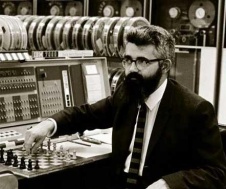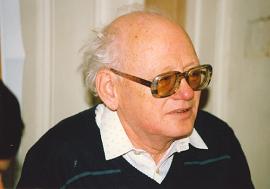Difference between revisions of "Stanford-ITEP Match"
GerdIsenberg (talk | contribs) (Created page with "'''Home * Tournaments * Stanford-ITEP Match''' '''Stanford-ITEP Match''',<br/> a four game correspondence match over nine months bet...") |
GerdIsenberg (talk | contribs) m |
||
| Line 8: | Line 8: | ||
=The Match= | =The Match= | ||
| − | {| | + | {| |
|- | |- | ||
| [[FILE:JohnMcCarthy.jpg|none|border|text-bottom|x189px|link=John McCarthy ]] | | [[FILE:JohnMcCarthy.jpg|none|border|text-bottom|x189px|link=John McCarthy ]] | ||
Revision as of 13:33, 29 May 2018
Home * Tournaments * Stanford-ITEP Match
Stanford-ITEP Match,
a four game correspondence match over nine months between the Kotok-McCarthy-Program and the ITEP Chess Program starting on November 22, 1966.
Contents
The Challenge
In 1965, John McCarthy, by then at Stanford University, visited the Soviet Union. A group using the M-2 [1] computer at Alexander Kronrod’s laboratory at the Moscow Institute of Theoretical and Experimental Physics (ITEP) challenged him to a match. Kronrod considered the Kotok-McCarthy-Program to be the best program in the United States at the time [2].
The Match
| versus |
At the end of 1966 a four game correspondence match began between the Kotok-McCarthy-Program, running on a IBM 7090 computer, and a program developed at the ITEP, written by Georgy Adelson-Velsky, Vladimir Arlazarov, Anatoly Uskov, Alexander Zhivotovsky, and advised by Russian chess master Alexander Bitman and three-time world champion Mikhail Botvinnik [3].
The match played over nine months was won 3-1 by the ITEP program. Despite playing on weaker hardware, it was the better program. Based on Shannon Type A, it could took advantage on the tactical oversights of the Kotok-McCarthy-Program, caused by it flaws of the Shannon Type B plausible move generator.
Quotes
Cold War on an 8x8 Board
Excerpt from Competitions, Controversies, and Computer Chess [4]:
Round 1: In between 1950, when Shannon’s paper was first published, and 1966 only three chess programs were developed. By 1970 six programs (none from the initial three) participated in the first US Computer Chess Championship. The first World Championship in 1974 had 13 participants. This remarkable growth was largely spurred by a well publicized match between the Kotok/McCarthy program developed at MIT and Stanford University and a program developed at the Institute for Theoretical and Experimental Physics (ITEP) in Moscow. This match was a “first” in many ways: it was the first match between two computer programs.
It was the first match where a type A strategy faced a type B strategy. But most importantly it was a challenge in the Cold War scientific race. Just as putting a man into space, it was of no practical value, but it had similar psychological implications.
Alan Kotok developed his program while an undergraduate at MIT in collaboration with several other students and under the direction of John McCarthy. His program implemented a type B strategy, considering 4 moves at the first ply, 3 moves on second, 2 on levels three and four and 1 on five through eight. The payoff function considered such elements as material (the main component), development, control of the center, and pawn structure. It also did not use several of the latest algorithmic improvements made between its initial creation (1962) and the match, most notably alpha-beta and the killer heuristic. It had a weak plausible move generator, causing Botvinnik to remark that “the rule for rejecting moves was so constituted that the machine threw out the baby with the bath water.” [Botvinnik 1967]
The Soviet program was implemented by Georgiy Adelson-Velskiy, Vladimir Arlazarov, Alexander Bitman, Anatoly Uskov, and Alexander Zhivotovsky, working in Alexander Kronrod’s Laboratory. It implemented Shannon’s type A strategy, with the search depth set as a parameter. In games 1 and 2 the machine looked ahead 3 ply, while in games 3 and 4 a depth of 5 ply was used. The payoff function was similar to the one in the Kotok/McCarthy program, but an emphasis was placed on gaining a spatial advantage.
The match was played by telegraph, starting on November 22, 1966 and continuing for a year. All games were agreed drawn if no mate was delivered or announced in 40 moves, as both programs showed complete incompetence in the endgame. In games one and two, against the weaker version of the ITEP program Kotok/McCarthy drew twice through the 40 move rule, although it was slightly worse in one of the games and much worse in the other. It was thoroughly beaten in both of the games against the stronger version, losing game three in 19 moves and game four in 41. In all of the matches the ITEP program was playing slightly better positional chess: because of the emphasis on space advantage the ITEP program was better at pushing pawns forward. It won, however, not because of any superiority in positional play, but by taking advantage of blunders on the part of the American program. [Newborn 1975] Because there were possible moves that were much better then the moves the Kotok/McCarthy program actually made, it was clear that the program failed to consider them at all, indicating a weakness in the plausible move generator. Thus the first round was won by the Russians and by the type A approach, and although the Soviet dominance in Computer chess was short-lived, the dominance of type A approaches continues today. This match has a very sad postscript: Alexander Kronrod, the head of the Computational lab at ITEP, was a highly principled person who, among with many other mathematicians, signed a letter in defense of Esenin-Volpin, a mathematician who was placed in an insane asylum for anti-Communist views. For his signature of the letter Kronrod was reprimanded by the Communist Party. The physicists at ITEP, who were irritated because computer time was “wasted” on game playing instead of their problems used the reprimand as an excuse to oust Kronrod from his position. At the same time Kronrod was fired from his professorship at the Moscow Pedagogical Institute. These actions effectively ended the career of this brilliant mathematician.
Biography AS Kronrod
Quote from Biography AS Kronrod by Alexander Yershov [5]
In 1958, Kronrod, Adelson-Velsky, and Landis selected "Snap" ("подкидного дурака") as the intellectual foundations for the development of the game heuristic programming [6]. The program itself was a fiasco - but the basic principles (board games, search techniques and limited depth) were formulated. Further research laboratories in the field of game theory culminated in the first ever chess duel between the program of the Institute of Soviet and American best program developed at Stanford University under the direction of J. McCarthy. By telegraph match was played in four games ended 3-1 in favor of our institute. At the time, chess became a guinea pig for all programmers interested in artificial intelligence.
Games
See also
Publications
- Monroe Newborn (1975). Computer Chess. Academic Press, New York, N.Y. ISBN 0-125-17250-8.
- Chapter III. The Kotok-McCarthy Chess Program versus the ITEP Chess Program
External Links
- Kotok-McCarthy-Program from Wikipedia
- Opening Moves: Origins of Computer Chess from The Computer History Museum
References
- ↑ The Fast Universal Digital Computer M-2 from the Russian Virtual Computer Museum
- ↑ Evgenii Landis, Isaak Yaglom (1987). Remembering A.S. Kronrod. (2002). Translation by Viola Brudno, Edited by Walter Gautschi, ps
- ↑ International Grandmaster and World Champion Mikhail Botvinnik in Moscow, 1980, Gift of Monroe Newborn, "Botvinnik served as a consultant to Soviet computer chess developers who developed an early program at ITEP which won a correspondence chess match against a Stanford University chess program led by John McCarthy in 1967. Later he advised the team that created the chess program Kaissa at Moscow’s Institute for Control Science"
- ↑ Michael Brudno (2000). Competitions, Controversies, and Computer Chess, pdf
- ↑ Биография А.С. Кронрода (Biography AS Kronrod) by Alexander Yershov
- ↑ Boris Polyak. Memories.

